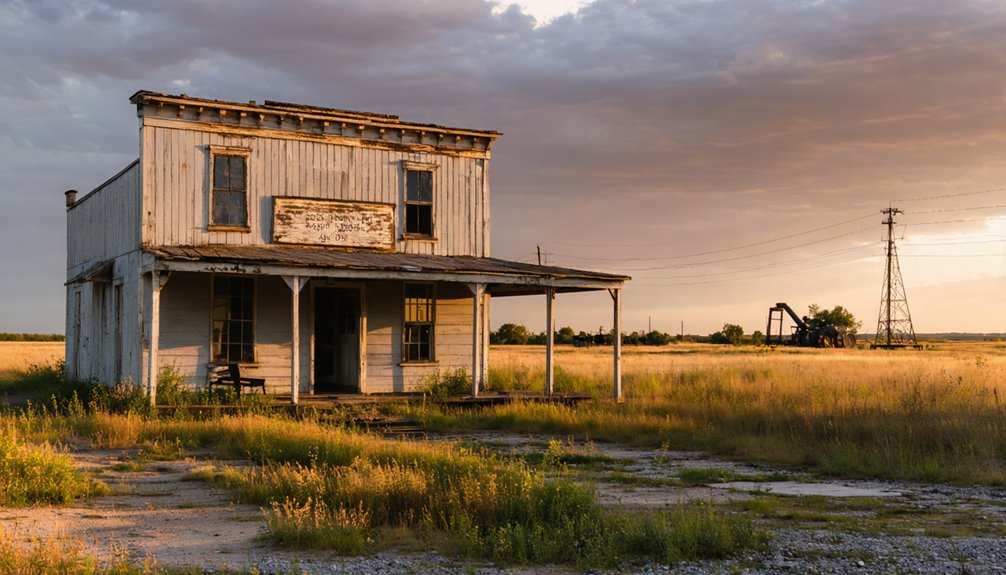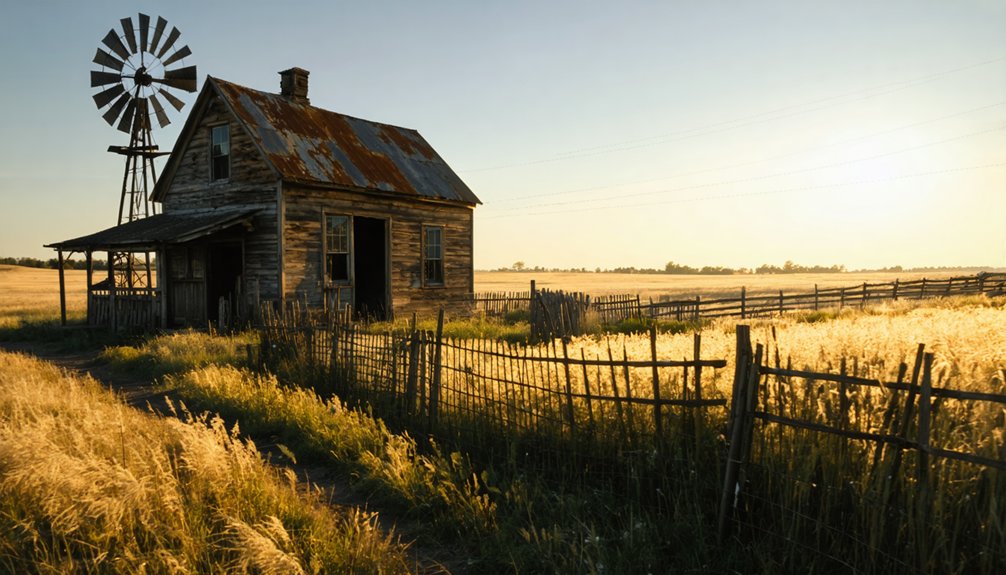You’ll discover Nockenut in Wilson County, Texas, where German and Polish immigrants established a thriving agricultural settlement in 1857. The community peaked in the 1890s with 80 residents, a cotton gin, general store, and post office managed by the influential Hastings family. When the Galveston, Harrisburg and San Antonio Railroad bypassed Nockenut in 1906, the town’s decline began swiftly. Today, only scattered remnants and a cemetery hint at the rich cultural heritage that once defined this frontier community.
Key Takeaways
- Nockenut became a ghost town after being bypassed by the Galveston, Harrisburg and San Antonio Railroad in 1906.
- The town’s population dramatically declined from 80 residents in 1890 to just 10 by 1990.
- Originally established in 1857 by German and Polish immigrants, Nockenut was a thriving agricultural community centered on cotton production.
- Joseph P. Watkins’ cotton gin and store formed the commercial heart of Nockenut during its peak years from 1885-1890.
- Today, only scattered remnants and a cemetery remain as evidence of this once-prosperous German-Polish farming settlement.
Settlement Origins and Early Years
When German and Polish immigrants expanded from nearby communities like Panna Maria and Marion in 1857, they established the rural settlement of Nockenut in what was then Guadalupe County, Texas.
You’ll find that despite settlement challenges, the community quickly secured its position with the opening of a post office in 1858, marking its significance as a frontier outpost.
Rather than developing as a concentrated town, Nockenut emerged as a scattered rural settlement. The community experienced modest demographic shifts, growing to about 75 residents by 1885 and reaching 80 by 1890. The population significantly declined after railroads were built further south of the settlement.
Nockenut’s scattered settlement pattern defied traditional town planning, with its modest population growing slowly from 75 to 80 residents between 1885-1890.
A significant administrative change occurred in 1869 when boundary adjustments moved Nockenut from Guadalupe County to Wilson County, where it remains historically recognized today. The settlement developed around Ecleto Creek, a spring-fed waterway that provided year-round water access for the community.
German and Polish Immigrant Heritage
This cultural blending created a unique community where both groups maintained strong ties to their roots.
Heritage preservation flourished through bilingual schools, religious institutions, and social gatherings.
The settlement’s churches served as anchors for both communities, while traditional dance halls and shooting clubs reflected the German influence.
Many settlers began as sharecroppers before eventually purchasing their own farmland.
You can still trace this immigrant legacy in local cemeteries, where headstones tell stories of these pioneering families.
Polish traditions were celebrated through annual Catholic Church feasts and festivals that brought the community together.
The Rise of a Rural Community
You’ll find Nockenut’s early settlement coalescing around Ecleto Creek in 1857, with the establishment of a post office the following year marking its formal organization as a community.
The town’s commerce grew steadily through the 1880s, centered on a cotton gin and general store operated by prominent residents like Joseph P. Watkins and E. E. Hastings. Like many settlements during westward expansion, Nockenut emerged as pioneers sought new opportunities in Texas.
The thriving settlement included a wagon yard where travelers could rest their horses and make repairs.
Essential community services, including a school and church, were in place by 1890, serving the growing population that approached 100 residents at its peak.
Early Settlement Patterns
Amid the waves of European immigration to South Central Texas, Nockenut emerged in 1857 as a distinctive rural settlement, drawing Polish and German families seeking farming opportunities near Ecleto Creek.
The cultural integration of these immigrant groups shaped the community’s identity, with agricultural practices centered around the area’s fertile land and abundant natural resources. Similar to other communities like Calaveras, brick manufacturing became an important local industry. By 1885, the community had grown into a village with a population of 75 residents.
You’ll discover three key factors that defined Nockenut’s early settlement pattern:
- Strategic location near spring-fed Ecleto Creek enabled year-round farming and ranching
- Dense hickory and anaqua tree populations provided essential resources for building and industry
- Connection to established ethnic communities in Karnes and Guadalupe counties strengthened the settlement’s growth
The Hastings family’s entrepreneurial spirit transformed this rural enclave, establishing crucial infrastructure including a sawmill, cotton gin, and grist mill.
Commerce and Cotton Growth
During the late nineteenth century, Nockenut’s transformation into a thriving agricultural hub centered primarily around cotton cultivation, which revolutionized the local economy after the Civil War.
You’ll find that immigrant farmers from the Deep South and Europe brought diverse cotton varieties and agricultural techniques to the region in the 1870s, achieving impressive yields of up to one bale per acre on the fertile prairie soil. Barbed wire and expanding railroad networks helped protect and transport the growing cotton production in the area.
The community’s commercial heart beat strongest at Joseph P. Watkins’ cotton gin and store, established by 1885. Much like other Texas communities, cotton production became a major economic force as early settlers cultivated the available lands.
Local merchants like E. E. Hastings operated general stores that supported the intricate network of tenant farmers and sharecroppers.
Through the crop-lien system, these establishments became essential links in Nockenut’s cotton economy, though often leaving workers in a cycle of debt to landowners.
Community Services Established
As Nockenut’s cotton economy flourished, the community’s foundational services took shape through the determined efforts of its earliest settlers. The Hastings family emerged as key leaders, establishing essential services that would strengthen community cohesion in this German and Polish settlement.
- You’d find the post office, established in 1858, serving as the cornerstone of communication, with H.S. Hastings as postmaster and A.G. Hastings managing mail delivery from Seguin.
- E.E. Hastings’ general store became the commercial heart, providing necessary supplies and a gathering place for residents.
- The postal significance extended beyond simple mail delivery, creating crucial links to regional networks and commerce.
These services sustained Nockenut’s growth until the early 1900s, when railroad development in other towns began drawing residents and businesses away.
Peak Years and Economic Activities

During Nockenut’s peak years, you’ll find that cotton gin operations formed a vital part of the local agricultural economy, processing harvests from surrounding farms.
You’d see farmers bringing their cotton to be processed while conducting other business at the general store, which served as the town’s primary commercial hub.
The general store, operated by the Hastings family, provided essential supplies and served as a gathering place where you could purchase goods, collect mail, and exchange news with fellow residents.
Cotton Gin Operations
The cotton gin’s operations in Nockenut reached their zenith between 1885 and 1906, transforming the small Texas settlement into a bustling agricultural hub.
You’d find wagons lined up during peak season, as farmers brought their cotton for processing at this essential economic center operated by Joseph P. Watkins.
During harvest season, you could witness:
- Round-the-clock operations extending up to 24 hours daily
- Cotton grading and price negotiations between buyers and farmers
- A flurry of activity at adjacent businesses serving the agricultural economy
The gin’s presence cemented Nockenut’s status as a cotton-farming powerhouse in Wilson County, supporting both small and large-scale farmers.
This agricultural cornerstone drove the town’s growth until 1906, when the railroad’s bypass began shifting economic dynamics away from the community.
General Store Commerce
Life in Nockenut revolved around its bustling general store, which served as both a commercial hub and social center from 1885 to 1890 under operators E. E. Hastings and Joseph P. Watkins.
As the primary retail outlet in a town of 75-80 residents, the store’s general store dynamics reflected the self-sufficient nature of frontier living.
You’d find the establishment bustling with rural commerce, as local farmers and ranchers traded their cotton and livestock products while purchasing essential supplies.
The store operated alongside other businesses, including a grocer and wagonmaker, creating a diverse micro-economy.
Mail services, managed by postmaster H. S. Hastings and contractor A. G. Hastings, kept you connected to the outside world.
The store’s prominence continued until railroad lines bypassed Nockenut, leading to its eventual decline.
The Hastings Family Legacy
Prominent among Nockenut’s founding pioneers, Henry Solomon Hastings and his family shaped the destiny of this Texas settlement through their entrepreneurial spirit and civic leadership.
Their influence extended far beyond naming the town – they established crucial infrastructure and provided essential community administration that helped Nockenut thrive.
You’ll discover the Hastings family’s lasting impact through these pivotal contributions:
- Acquisition of 1,280 acres of land, which laid the foundation for the town’s development and growth
- Establishment of critical businesses including a sawmill, cotton gin, and grist mill that drove the local economy
- Leadership in civic duties, with H.S. Hastings serving as postmaster and other family members managing mail delivery from Seguin
The family’s dedication to Nockenut’s prosperity created a legacy that endures in Texas history.
Transportation Changes and Decline

Despite the Hastings family’s efforts to build a thriving community, Nockenut’s fate took a dramatic turn in 1906 when the Galveston, Harrisburg and San Antonio Railroad bypassed the settlement. This transportation evolution proved devastating for the town’s economy, as rail access had become essential for trade and commerce in early 20th century Texas.
The economic decline was swift and severe. You’d have seen Nockenut’s cotton gin, grocer, and wagonmaker struggle as shipping routes shifted to nearby rail-connected towns.
The town’s population, once nearly 100 residents, scattered by the 1930s. Without major transportation routes like highways or canals to compensate for the railroad bypass, Nockenut couldn’t sustain its commercial activities.
From Bustling Town to Ghost Town Status
Once a thriving agricultural community of nearly 100 residents, Nockenut’s transformation into a ghost town unfolded rapidly after 1906.
When the railroad bypassed the town, the social dynamics shifted dramatically, triggering a mass exodus of businesses and families seeking better opportunities elsewhere.
- Your great-grandparents might’ve witnessed Nockenut’s vibrant period, with its cotton gin, general store, and post office serving as community anchors.
- You can trace the town’s demographic shifts through its population decline – from 80 residents in 1890 to just 10 by 1990.
- You’ll find only scattered remnants today, with the cemetery standing as the last indication of this once-bustling community.
Historical Significance in Wilson County

The historical imprint of Nockenut extends far beyond its ghost town status, representing a significant chapter in Wilson County’s development.
You’ll find its Nockenut heritage deeply rooted in the immigrant settlement patterns of mid-19th century Texas, where German and Polish settlers established thriving agricultural communities along Ecleto Creek.
The town’s story mirrors broader regional themes, from its rise as a self-sufficient farming community to its eventual decline when bypassed by railroad development.
With its cotton gin, general store, and grist mill, Nockenut exemplified the economic independence that early Texas settlements aimed for.
While the physical town has faded, its legacy lives on through the surrounding cemeteries, historic springs, and architectural remnants that tell the tale of Wilson County’s agricultural origins and cultural transformation.
Frequently Asked Questions
What Natural Disasters or Events Contributed to Nockenut’s Decline?
You won’t find any major flooding events or drought conditions directly causing the town’s decline, as historical records don’t document significant natural disasters impacting the community’s fate.
Are There Any Preserved Buildings or Structures Still Standing Today?
You’ll find no preserved architecture still standing in Nockenut today except for the cemetery. While a historical landmark marker was installed in 2001, all original buildings have completely vanished.
What Happened to the Descendants of Nockenut’s Original Settler Families?
You’ll find descendant stories scattered across Texas, as families sought economic opportunities in urban areas and neighboring towns. Family legacies continue through those who migrated to more prosperous regions.
Can Visitors Legally Explore the Remaining Sites in Nockenut?
Like a fortress behind invisible walls, you’ll need explicit permission to explore, as most remaining sites are on private property. Legal access requires following visitor guidelines and landowner consent.
Were There Any Notable Crimes or Conflicts in Nockenut’s History?
You won’t find any recorded murder mysteries or land disputes in historical records. The community’s decline was purely economic, with no documented crimes or conflicts worth noting in its history.
References
- https://www.wilsoncountyhistory.org/talk-nockenut
- https://www.youtube.com/watch?v=PsuLwAQ12QI
- https://www.ksat.com/holidays/2018/10/30/texas-has-more-ghost-towns-than-any-other-state/
- https://en.wikipedia.org/wiki/List_of_ghost_towns_in_Texas
- https://www.hmdb.org/m.asp?m=207564
- https://www.tshaonline.org/handbook/entries/nockenut-tx
- https://www.texasescapes.com/SouthTexasTowns/Nockenut-Texas.htm
- https://www.texasescapes.com/SouthTexasTowns/Union-Valley-Texas.htm
- https://txwilson.genealogyvillage.com/communities.html
- https://www.youtube.com/watch?v=phjUE19A8HM



